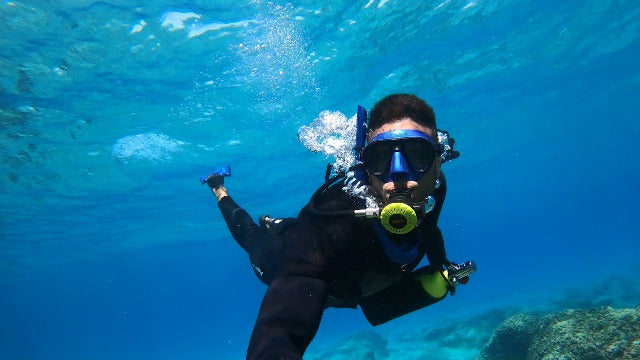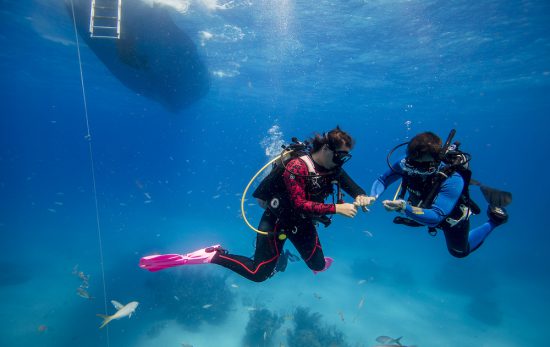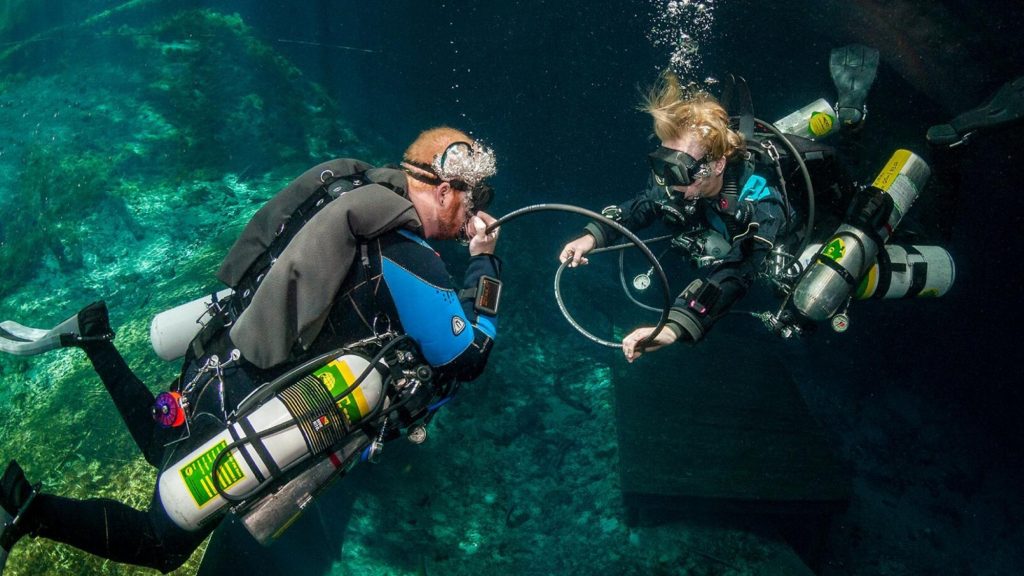Yes, you can use a mini scuba tank (like a 1-3 liter pony bottle) for snorkeling, but consider: 1) Limited air supply (5-15 minutes at 10m depth); 2) Weight and buoyancy challenges; 3) Requires basic scuba training for safe use; 4) May disrupt snorkeling’s simplicity; 5) Cost ($$$ vs. free snorkeling). Ideal for short deep dives but impractical for casual surface snorkeling.
Air Supply Limits
A mini scuba tank, often called a pony bottle, typically holds 1 to 3 liters of compressed air. At 10 meters (33 feet), a 1-liter tank lasts about 5 minutes for an average breather, while a 3-liter tank might stretch to 15 minutes.Unlike standard scuba tanks (10-15 liters), mini tanks are not designed for extended use.
Key Factors Affecting Air Consumption
-
Depth: Air lasts half as long at 10m vs. surface due to pressure.
-
Breathing Rate: Calm snorkelers use 10-15 liters per minute, while stressed or active divers hit 25+ liters/min.
-
Tank Size: A 2-liter tank at 200 bar holds 400 liters of air—enough for 8-12 minutes at moderate depth.
Comparison: Mini Tank vs. Traditional Snorkeling
|
Metric |
Mini Scuba Tank |
Standard Snorkeling |
|---|---|---|
|
Air Supply |
5-15 minutes (at depth) |
Unlimited (surface) |
|
Weight |
2-4 kg (added drag) |
None (just a snorkel) |
|
Cost |
400 (tank + reg) |
100 (mask/snorkel) |
|
Best For |
Short deep dives |
Relaxed surface swimming |
Practical Implications
A 3-liter tank adds 3.5 kg of weight, making swimming more tiring. If you dive below 5 meters often, air drains twice as fast as at the surface.
Just know the limits: even a 3-liter tank won’t last long if you’re moving around a lot.
When It Makes Sense
-
Spearfishing: Short dives to 8-12 meters with a safety backup.
-
Reef Exploration: Brief 5-10 minute dives to inspect coral.
-
Training: Practicing buoyancy before full scuba certification.
If you really need underwater time, a small 5-liter scuba tank (30+ minutes) is a better investment.
Weight & Buoyancy
A typical 1-3 liter aluminum pony bottle weighs 2.2 to 4.5 kg (5 to 10 lbs) when empty, but once filled with air at 200-300 bar, it adds noticeable drag. For comparison, a standard snorkeling setup (mask, snorkel, fins) weighs less than 1 kg, making it effortless to swim at the surface.
Key Considerations for Weight & Buoyancy
-
Drag & Swimming Efficiency: A 3-liter tank adds 3.5 kg of mass, increasing drag by 15-20% compared to snorkeling without one.
-
Buoyancy Shift: A full 2-liter tank at 200 bar loses 1.2 kg of negative buoyancy as you consume air, which can make surfacing unexpectedly fast if you’re not prepared.
Who Should (and Shouldn’t) Use a Mini Tank for Snorkeling?
But if you’re doing short, repeated dives below 5 meters (like spearfishing or underwater photography), the added air supply can be worth the trade-off. Just remember: the deeper you go, the faster you burn air, and the more buoyancy changes affect you.
Alternatives to Mini Tanks
If you want longer bottom time without the bulk, consider:
-
Freediving training (increases breath-hold to 2-3 minutes with practice).
-
Snorkel vests (provide buoyancy without the complexity of scuba gear).
-
Smaller, lighter air sources (like Spare Air, though they have even less capacity).
Basic Training Needed
For example, a 1-liter tank at 200 bar holds 200 liters of air, but if you panic and breathe rapidly at 30 liters per minute, you’ll drain it in less than 7 minutes—even faster if you’re deeper than 5 meters.
A single-day introductory scuba course (often 200) covers these essentials, while a full certification (PADI Open Water, for example) takes 3-4 days and costs 600. But if you plan to dive below 3-5 meters regularly, training reduces risks significantly.
Key Skills You Need Before Using a Mini Tank
-
Regulator Handling: Knowing how to clear water from the mouthpiece (a skill most snorkelers don’t practice).
-
Air Monitoring: Checking pressure gauges to avoid running out unexpectedly (mini tanks deplete 3x faster at 10m vs. the surface).
-
Emergency Procedures: What to do if you suck the tank dry at depth (ascending safely without a breath-hold).
-
Buoyancy Control: Adjusting your body position as the tank gets lighter (a full 2-liter tank loses 1.2 kg of weight as air is used).
Who Actually Needs Training?
If you’re only surface snorkeling, training is overkill—you don’t need a mini tank in the first place. But if you’re:
-
Freediving deeper than 5 meters and want a backup air source.
-
Spearfishing and need short bursts of air after long dives.
-
Exploring reefs and want extra time at depth.
Alternatives to Full Scuba Certification
If you don’t want to commit to a full course, some dive shops offer "try diving" sessions (around 100 for 1-2 hours) that teach the basics.
Cost vs. Convenience
Mini scuba tanks present an interesting trade-off between upfront investment and practical benefits. Let's break down the numbers:
|
Cost Factor |
Mini Scuba Tank |
Traditional Snorkeling |
|---|---|---|
|
Initial Setup |
600 (tank + regulator) |
150 (mask + snorkel) |
|
Maintenance |
100/year (inspections) |
20/year (replacements) |
|
Air Fills |
15 per fill |
Free (breathe naturally) |
|
Training |
600 (optional but recommended) |
None required |
|
Lifespan |
5-10 years with proper care |
2-5 years for basic gear |
A 2-liter aluminum tank weighing 3.1 kg gives you about 10-15 minutes of bottom time at 5-8 meters depth, compared to the 1-2 minute breath-hold of typical freediving. This extended underwater time comes at a 3-5x higher cost than basic snorkeling gear.
Here's what you're really paying for:
-
Portability: Mini tanks are 40-60% smaller than standard scuba tanks (typically 50-80cm tall vs. 90cm+)
-
Quick Setup: No bulky BCD needed - just strap on and go (saves 5-10 minutes per dive)
-
Flexibility: Can be used for both surface snorkeling and short dives (dual-purpose)
But the hidden costs add up quickly:
-
Air consumption rates of 15-25L/min mean frequent refills (every 2-3 dives)
-
Annual hydrostatic testing (80) required for safety compliance
-
Limited depth range (recommended max 12m vs. 30m+ for full scuba)
For casual snorkelers who spend 80% of their time at the surface, the cost-benefit ratio doesn't make sense. You'd need to use the mini tank at least 15-20 times per year to justify the investment over traditional gear. However, for these specific users, the convenience may be worth it:
-
Underwater photographers needing extra seconds to frame shots
-
Spearfishers requiring quick air access after deep dives
-
Reef researchers documenting marine life at moderate depths
The break-even point comes at about 30-40 dives - after that, the per-use cost drops below $5/dive.
They're not cheap and not for everyone, but when used for their intended purpose (short, frequent dives in the 5-12m range), they can provide good value compared to more expensive alternatives.
Best Use Cases
Mini scuba tanks aren't for everyone, but they absolutely shine in specific situations where their compact size (typically 40-60cm tall) and short-duration air supply (5-15 minutes at depth) provide just the right balance between convenience and functionality. The key is understanding exactly when that 3-5kg of extra equipment weight pays off with tangible benefits.
While most snorkelers get 30-60 seconds to frame a shot before surfacing, a 2-liter mini tank provides 4-6 minutes of continuous bottom time at 5-8 meter depths. This means 5-10x more shooting opportunities per dive without the bulk of full scuba gear.
After a deep dive to 10-12 meters, a few breaths from the tank during ascent can reduce surface recovery time by 50-70%, allowing for more frequent dives. The tanks work best when mounted on the hip or chest (adding only 2-3kg of frontal weight) to maintain streamlined movement. Most spearfishers report 20-30% more successful catches when using mini tanks versus pure freediving, especially when targeting deeper reef fish.
Monitoring coral polyps or fish behavior requires continuous 5-10 minute viewing windows - impossible with normal snorkeling. A 3-liter tank provides enough air for 12-15 minutes of relaxed breathing at 3-5 meters, yielding 3-5x more data collection per dive compared to surface observations.
-
Coastal lifeguards use mini tanks for rapid response (reaching distressed swimmers 30-50% faster than swimming alone)
-
Underwater maintenance crews performing short 5-7 minute hull inspections on small boats
-
Freediving students practicing equalization at 4-6 meter depths with a safety air source
-
Snorkel tour guides demonstrating reef features to groups without constant surfacing
Mini tanks hit the sweet spot of providing just enough air (typically 200-300 liters in a 1-3L tank) for specialized tasks without the complexity of full dive systems.
For casual recreational snorkelers who spend 80%+ of their time at the surface, these tanks rarely justify their cost or weight.The key is matching the tool to the task - when used within their optimal 5-12 meter depth range for under 15 minute durations, outperform both traditional snorkeling and full scuba setups in terms of efficiency and convenience.






Leave a comment
All comments are moderated before being published.
Este site está protegido pela Política de privacidade da hCaptcha e da hCaptcha e aplicam-se os Termos de serviço das mesmas.